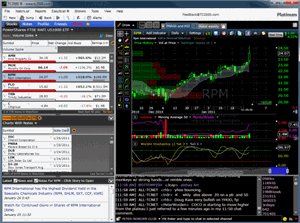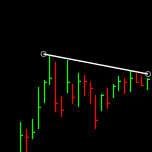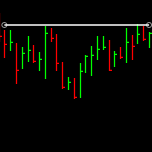 All Entries in the "Trading Tips" Category
All Entries in the "Trading Tips" Category
Premature Evacuation from Trades
May 23, 2011 at 10:10 am
 All of us have the occasional urge to jump ship early from a trade, but when is it the right time and how should that be done?
All of us have the occasional urge to jump ship early from a trade, but when is it the right time and how should that be done?
Let’s take a look at a conversation I recently had with a trader I was helping…
Hey Jeff,
I’m long ***, as it just looked like a nice setup. I went long 4 days ago, but it is behaving horribly. Currently I don’t see any pattern and would not make this trade now, but it is only halfway to my stop loss. I am unsure what to do. How do you approach trades you aren’t convinced of anymore, but have not been stopped out of?
Also, one of the mantras I read often is “cut losses short, let winners ride.” I am wondering how to interpret this “cut losses?” I find myself thinking, “I am not convinced in this trade anymore, but maybe it will turn around, it’s just half a position left to lose.” When my analysis of the situation shifts, and I wouldn’t take this trade anymore as of today, do I abandon my original plan and exit immediately or should I stay with the trade?
C.
==
Here’s what I told him…
C,
Let me start off by addressing the “cut losses short” question. I don’t have all the answers, but I can tell you that for me, cutting losses means having an exit plan on the downside with defined risks. We will all be wrong at times, but staying wrong is different – don’t stay wrong! Limit your losses so that they can be overcome with reasonable winning trades. Don’t dig a hole so deep you need a miracle to get out – that’s cutting your losses short.
Now let’s discuss early exits on trades like this where your conviction level has changed…
Occasionally you’ll find trades like this which don’t completely fail (stop you out), yet don’t work either (move to your targets). Instead, they just begin to stagnate and enter into a trading range where your funds are tied up. It can be a bit frustrating, simply because you’re left in limbo, wondering if the trade is in the process of failing or working. Each new red or green bar feels like the start of something meaningful, but they’re followed by the opposing color and you soon realize that price is simply showing indecision.
A key consideration to make when this happens is whether the character of the stock has changed. Stated otherwise, do you have a good reason to now lack conviction, or is it merely a mood shift for you?
A slow-moving trade is far different than one which may have just experienced an important technical event…
- Just because a trade isn’t developing quite as quickly as you would have wanted doesn’t mean it’s destined for failure.
- The stock may be building a new pattern which you simply haven’t identified yet.
- When I find myself in a trade which is starting to bore me, I know I’m overanalyzing when I start looking for signals which aren’t there.
- If I’m positioned in accordance with the overall market (ie: long in a market uptrend), and if my trading capacity isn’t restricted because of this position (I don’t need to free up capital), then what I need to do is stay with the trade until a technical reason prompts an exit. I likely need to stay patient, as this is still a trade which can pay me.
On the other hand, there are times when a premature exit may be warranted…
- When the stock has just seen a change in character as measured by a technical event (high-volume reversal, for example), an adjustment may be called for.
- If your trading funds are limited and you’d rather shift into a better idea, then you might consider closing out the trade in favor of another with more promise.
- When you find yourself positioned in opposition to the prevailing market trend (ie: long in a market downtrend), then you have grounds to at least lighten up. That can be done either by reducing your position while maintaining your original stop & target parameters for the trade, or by tightening both your risk and objective.
What else could help C. in this situation?
Trade Like a Bandit!
Jeff White
Producer of The Bandit Broadcast
Are you following me on Twitter yet?
Webinar: Tuesday, April 19
April 15, 2011 at 2:49 pm
I wanted to be sure to invite you to the webinar I’ll be presenting on Tuesday (April 19th) with the folks from Worden – there’s no charge and I hope you can join us!
Locating Trade Candidates with TheStockBandit
 It’s scheduled to be a 45 minute webinar, the first 30 minutes of which I’ll be going through my watch lists, pointing out to you what I’m seeing in the charts for both the overall market and individual stocks.
It’s scheduled to be a 45 minute webinar, the first 30 minutes of which I’ll be going through my watch lists, pointing out to you what I’m seeing in the charts for both the overall market and individual stocks.
There will be 15 minutes of Q&A time at the end where you might want to bring forth your favorite stock and we can take a look at those too.
It’s going to be a chance for me to convey what I’m seeing out there and hopefully not only teach you a few things, but also put many stocks on your radar which you may find of interest.
I’ll also be covering some of the latest developments in how stocks are moving, helping you avoid some of the “obvious” setups which are trapping traders frequently in today’s environment.
Oh, and the best part about it is that this event will be FREE, so be sure to register at this link for details (and access to the recorded version if you can’t attend live):
Locating Trade Candidates with TheStockBandit
Remember: this Tuesday night, 45 minutes of charting reading with you and me – I can’t wait!
Jeff White
Producer of The Bandit Broadcast
Are you following me on Twitter yet?
Trend Line Entries: Tilted or Flat?
April 5, 2011 at 2:00 pm
I take a lot of trend line trades, as they give me a clear indication that price is either clearing an important level, or that it’s making a meaningful turn.
Recently I was asked why some of those trend lines are flat (lateral), and others are tilted. Additionally, I was asked how I determine my entries on each. Here’s what I said:
Whenever a trend line is slanted, I go with a break of the trend line itself. In the case of a bullish trend line break (a move above a descending trend line), I’ll place a buy stop just above the line itself, perhaps only a couple of pennies above it. These tilted trend lines are themselves the resistance for a stock, so once they’re broken, the stock tends to be free to move higher.

Whenever there’s a flat trend line of support or resistance, it’s evident that price is bumping up against a key zone which remains constant. Sometimes this is at a round number, like $100, but it doesn’t have to be. The way I trade these flat trend lines is to set a buy stop 10-15 cents past the resistance zone, as that will help to confirm I’m entering upon a true breakout that’s taking place rather than a brief penetration of only 1-5 cents which could prove to be a head fake.

When you’re drawing your trend lines, consider the overall situation. Is price struggling to clear a constant level? Use a flat trend line if so. If price is simply seeing a counter-trend pullback, then the pace of the pullback is better seen with a tilted trend line .
Trade Like a Bandit!
Jeff White
Producer of The Bandit Broadcast
Are you following me on Twitter yet?
Reminder: Webinar Tonight!
December 7, 2010 at 2:07 pm
Here’s a quick reminder about tonight’s free trading webinar, as I would love to see you there if possible.
Update: here’s a link to the webinar recording – enjoy!
Weighing Risk & Reward with TheStockBandit
I’m excited to run through a number of interesting chart setups, from both the bullish and bearish sides, in order to teach you some concepts and of course put some quality plays on your radar.
I also plan to share with you the most powerful pattern I’ve been trading in recent weeks.
The webinar is scheduled to run 45 minutes, with 15 of those minutes set aside at the end for Q&A and a look at your favorite charts.
Visit this link for registration to the 8pm ET webinar:
Weighing Risk & Reward with TheStockBandit
See you tonight!
Jeff White
Producer of The Bandit Broadcast
Are you following me on Twitter yet?
Webinar Tuesday December 7
December 6, 2010 at 10:38 pm
I wanted to be sure to post a quick announcement here that I’ll be presenting a Free Webinar on Tuesday (December 7th) with the folks from Worden, and I hope you can join us!
Update: here’s a link to the webinar recording – enjoy!
Weighing Risk and Reward with TheStockBandit
It’s scheduled to be a 45 minute webinar, the first 30 minutes of which I’ll be going through my watch lists, pointing out to you what I’m seeing in the charts for both the overall market and individual stocks.
There will be 15 minutes of Q&A time at the end where you might want to bring forth your favorite stock and we can take a look at those too.
I certainly do not have all the answers, but it’s going to be a chance for me to convey what I’m seeing out there and hopefully not only teach you a few things, but also put many stocks on your radar which you may find of interest.
Oh, and the best part about it is that this event will be FREE, so be sure to register at this link for details (and access to the recorded version if you can’t attend live):
Chart Reading with TheStockBandit
Remember, free webinar this Tuesday night, 45 minutes of charting reading with you and me – I can’t wait!
Jeff White
Producer of The Bandit Broadcast
Are you following me on Twitter yet?
Options vs. Common Stock
November 17, 2010 at 11:13 am
 Traders face many hard decisions every day…buy or sell, add or lighten, stand aside or get involved. Among them is the choice between trading options or common stock.
Traders face many hard decisions every day…buy or sell, add or lighten, stand aside or get involved. Among them is the choice between trading options or common stock.
There are no doubt benefits and shortcomings of both choices, as everything literally is a trade-off.
Common is usually much more liquid, it can be traded in the after hours or premarket, and it’s by definition 100% exposure to the company. However, it is more capital-intensive since it’s not a leveraged position, which means less room for other positions in an account. Common alone is also going to carry with it greater dollar risk, as a major headline can bring tremendous gap potential.
Options are leveraged, they offer lots of versatility and possibilities (speculation, hedging, income, etc.), and they are less capital-intensive. However, liquidity is often inferior compared to common, they can’t be traded as many hours of the day as stock, and they offer only fractional exposure to the underlying stock.
The Case for Options
Options can be an excellent vehicle for trading, provided the situation is well-suited to them. The biggest 3 considerations for options are (1) the time expectation for the trade, (2) the liquidity of the options being traded, and (3) the risk involved in the trade. Let’s break those down.
Timeframe
First things first… The time you expect to be in the play is important because options will carry a bid/ask spread often times up to maybe .10-15 cents. For a stock that’s not a huge deal, but for an option which might only be trading at say $2 or lower, that’s a big percentage if you pay the spread both ways (market order getting in & out). So if you’re looking at being in a trade for at least a couple of days, that’s usually much better for an options trade than if you’re just looking to scalp it over the next half hour.
Liquidity
Second, there are quite a few stocks which have high trading volume, but for whatever reason their options are just not heavily traded. For any trade I take, whether a stock or an option, I want to feel confident there will be buyers when I go to sell, and sellers when I go to buy. Sufficient liquidity is a requirement for any trade, whether in options or common. So taking a look at the open interest, the volume, and the bid/ask spread is important in gauging the liquidity of the options. When in doubt, take a look at the highly liquid options like QQQQ, SPY, or mega-cap stocks like MSFT or INTC. That will help you get a feel for how tight the market is in the options you’re considering. You don’t ever want to be the ‘big player’ in any contract.
Risk
Third, limited risk is an advantage which options carry, such as buying put options vs. being short stock. Risk is defined with the puts, and theoretically unlimited with the short stock. Options are a great choice in particular when the stock has the potential to gap big, whether due to news coming out or simply based upon recent price history of the stock. Always consider the risk involved when weighing options vs. common, as that’s an important element of the decision-making process.
Finally, here are a few occasions to consider options rather than the common shares:
1. In front of big news (earnings, conference calls, or anything else scheduled).
2. When limited on capital (the leverage of options helps offset a limited amount of funds).
3. When the stock moves are too shaky to sit through (when a really wide stop is necessary).
4. Trade timeframe is between a couple days and a few weeks.
** If you’ve got something else to add, please share it in the comments.
Trade Like a Bandit!
Jeff White
Producer of The Bandit Broadcast
Are you following me on Twitter yet?
Uptrend Aside, Trading Scene Set to Improve
November 1, 2010 at 10:45 am
August seems so long ago, doesn’t it? Stocks had rebounded from their July lows, briefly, and had turned back down hard for a test. The test passed, as an important higher low was established.
From there, we all know the story of how the seasonally-weak September and October stood conventional wisdom on its head to post big gains. What’s not been spoken of much, however, is the way this 2-month rally has changed in recent weeks.
What began as a rip-roaring rise ripe with short-covering has evolved into a slower, more steady uptrend channel. The pace has cooled off a bit, while still continuing to make upward progress. In fact, new intraday highs were posted multiple times last week, despite the indecision we saw between the opening and closing bells each day. Today we’re seeing more of the same, as early strength has delivered new highs while modest profit-taking has caused the indexes to back down from their best levels.
To put it another way, the “dumb money” has had great success in recent weeks. Those who waited for strength to return before becoming confident enough to join in have been fortunate enough to chase extended markets and stocks and still profit. But for those of us who prefer to see some kind of rhythm associated with market moves, it’s been a one-way street without many ways to play the long side while still protecting the downside.
Astute traders have instead found it a bit more difficult to navigate the current environment, as anyone with an ounce of discipline has felt the uneasiness of adding long-sided exposure for overnights while simultaneously recognizing the limited opportunity of trading intraday. It has left many of us to do more scalping while waiting for more lively day-to-day price action and higher-quality bases to come along. Those bases often rely on some back-and-forth price action, which we simply haven’t seen of late.
Watch The Horizon
 Any trader worth his salt knows that conditions will shift. Maybe not immediately, but eventually.
Any trader worth his salt knows that conditions will shift. Maybe not immediately, but eventually.
That doesn’t mean prediction is necessary, because it isn’t, but it does mean staying alert.
When trading well, keep doing what works but be on the lookout for signs the setup may be changing. When trading poorly, it’s imperative to employ some other methods which are more suitable to the conditions. At the same time, hope can be had that a shake-up in the price action will bring more opportunities.
Right now, the market is in an interesting spot. The rally has brought the spring highs into play as we’re essentially testing them in this area. That’s a logical resistance area that could prompt some selling, depending upon the news flow. The uptrend channels seen in the averages could easily be penetrated to the downside, heightening concerns of whether that’s the end of the run. The other side of the coin is that the trend is still up, and no evidence has surfaced to suggest it’s changing.
So as a trader, here’s how I’m dealing with all this. The trend is up, so I’m favoring the long side while keeping timeframes short in order to offset the risk of walking the highwire here. I’m also mindful of potential shifts which could emerge anytime. We’re in the midst of earnings season, and that could easily sour the mood. We have the November elections tomorrow and the political implications of that, which is a major event. And then mid-week we have the FOMC, and with all eyes on the economy, the attention of traders will definitely be on Wednesday’s announcement and policy statement.
We could ramp from here and take out the spring highs before a pullback begins. It’s possible. We could break the uptrend channels and see some selling accelerate as traders recognize the trend line break and move quickly to lock in profits. Several scenarios are possible, and it’s important to keep an open mind here for that very reason.
I will say this: I’m expecting volatility to pick up sooner than later, and that means more opportunities for trading multiple timeframes. That’s where the real money is made, as you can have capital working for multi-day moves while still maneuvering to catch intraday moves for profits. Look alive out there, this is no time to get lulled to sleep.
Trade Like a Bandit!
Jeff White
Producer of The Bandit Broadcast
Are you following me on Twitter yet?






